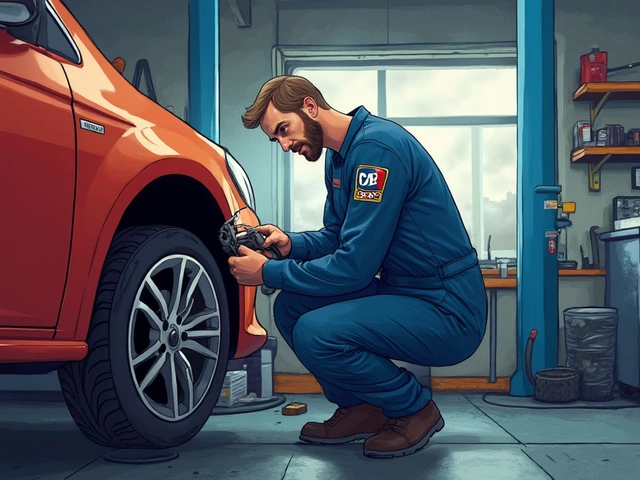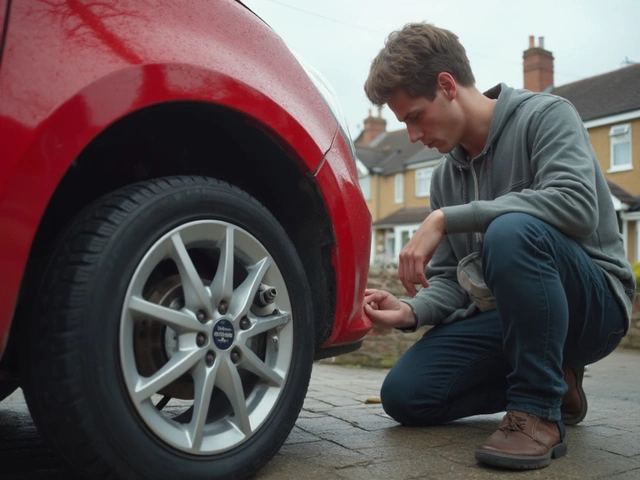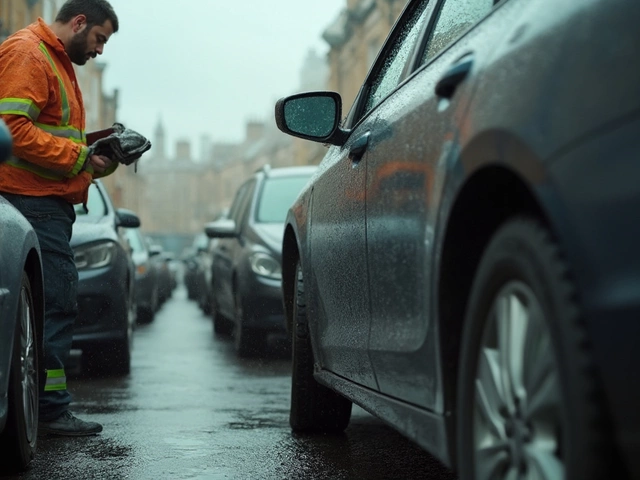Brake Pad Thickness Checker
Check Your Brake Pad Thickness
Measure the visible friction material thickness through your wheel spokes. Enter your measurement below to get immediate advice.
Brake pads are one of the most important safety parts on your car. Yet most drivers don’t check them until they hear a screech that sounds like nails on a chalkboard. By then, it’s often too late - the metal backing is grinding against your rotors, and repair costs jump from £100 to over £500. You don’t need a mechanic to tell you when your brake pads are worn out. There are clear, everyday signs you can spot yourself - if you know what to look for.
Listen for the squealing sound
That high-pitched squeal when you press the brake pedal? It’s not your car being dramatic. It’s a built-in wear indicator. Most modern brake pads have a small metal tab attached to the friction material. When the pad wears down to about 2mm thick, that tab scrapes against the rotor and makes a sharp, unmistakable noise. It’s designed to be annoying - because it’s your last warning before failure.
Don’t ignore it. Some drivers think it’s just "a little noise" and wait a few weeks. But brake pads don’t wear slowly after the indicator starts. They can go from 2mm to zero in under 100 miles, especially if you drive in city traffic or hilly areas. If you hear that squeal, get them checked within a week.
Feel for vibration or pulsing
When brake pads wear unevenly or rotors get warped from overheating, you’ll feel it in the pedal. A soft, spongy brake pedal that goes further to the floor than usual? That’s a sign the pads have lost contact surface. A pulsing or shaking sensation when you brake - especially at higher speeds - means the rotor is no longer flat. This happens when worn pads cause uneven heat buildup, warping the metal.
It’s not just uncomfortable. A warped rotor reduces stopping power. In wet conditions, your car might take 20% longer to stop. If you feel vibration every time you brake, don’t just blame the road. It’s your brakes telling you they’re past their limit.
Check the thickness - no tools needed
You can check your brake pad thickness without lifting the car. Just look through the spokes of your wheel. You don’t even need to remove the wheel. Most cars let you see the pad clearly through the rim.
Look for the metal backing plate. The friction material should be at least 4mm thick. If it’s less than 3mm, replace them now. If you can see the metal backing plate - meaning the friction material is gone - you’ve already damaged your rotors. At this point, you’re not just replacing pads. You’re replacing rotors too.
Take a photo with your phone every few months. Compare it over time. If the pad looks noticeably thinner than it did three months ago, you’re on a fast track to failure.

Notice longer stopping distances
Has your car started taking longer to stop? Maybe you’ve had to press the pedal harder than usual to get the same result. That’s not just "getting older." It’s a direct sign your brake pads are losing friction.
Brake pads work by creating friction against the rotor. As they wear down, the surface area shrinks. Less friction = less stopping power. In a panic stop, that difference could mean the difference between avoiding a collision and hitting it.
Test it safely. On an empty road, do a gentle stop from 40mph. Note how far it takes to stop. Do the same test every three months. If you notice a 10% increase in stopping distance, your pads are likely below 3mm.
See the warning light
Many cars now have a brake pad wear sensor. It’s a small electronic tab connected to the pad. When the pad wears thin, the sensor completes a circuit and turns on a yellow or red brake warning light on your dashboard. It looks like a circle with an exclamation mark inside, or sometimes just the word "BRAKE."
Don’t assume it’s low brake fluid. If the light comes on and your fluid level is normal, it’s almost certainly the pads. Some drivers ignore the light, thinking it’s a glitch. It’s not. The sensor doesn’t fail randomly. It’s triggered by physical wear.
Smell burning or overheating
If you catch a whiff of something like hot metal or burnt plastic when you brake, that’s not your exhaust. That’s your brake pads overheating - and possibly glazing. Glazing happens when pads get too hot and the friction material hardens, losing grip. It’s common after heavy braking, like driving down a mountain road with your foot on the brake.
That smell means the pads are either worn thin or already damaged. Even if they still look thick, the material has lost its ability to grip. You need new pads, and you need them now. Driving with glazed pads is like trying to stop a car with greased shoes.

How long do brake pads usually last?
There’s no fixed number. Brake pads can last anywhere from 25,000 to 70,000 miles. It depends on your driving habits. City drivers who brake often - stop-and-go traffic, frequent traffic lights - wear pads out faster. Highway drivers who coast more and brake gently can stretch them out.
Most manufacturers recommend checking them every 12,000 miles or once a year. In the UK, with our wet roads and heavy urban traffic, 30,000 to 40,000 miles is typical. If you’ve hit 50,000 miles and never checked them, you’re overdue.
What happens if you wait too long?
Waiting until the pads are completely gone doesn’t just cost more - it’s dangerous. Once the friction material is gone, the metal backing plate grinds directly on the rotor. That damages the rotor surface, creating deep grooves. A warped or scored rotor can’t stop the car properly.
Replacing just the pads costs between £80 and £150. Replacing pads and rotors? £250 to £500. And if the calipers get damaged from metal-on-metal contact? That’s another £300. You’re not saving money by waiting. You’re risking your safety and paying three times more.
What to do next
Don’t wait for the noise. Don’t wait for the warning light. Make checking your brake pads part of your regular car routine. Look through your wheels every time you wash the car. Take a photo every three months. If you’re unsure, get a free brake check at any reputable garage. Most will do it in 10 minutes while you wait for coffee.
Your brakes are your last line of defense. Don’t gamble with them. Replace them before they fail - not after.
How often should I check my brake pads?
Check your brake pads every 12,000 miles or at least once a year. If you drive mostly in the city or hilly areas, check them every 6,000 miles. Look through the wheel spokes - you don’t need to lift the car. If the friction material is less than 3mm thick, replace them.
Can I drive with worn brake pads?
You can, but you shouldn’t. Driving with brake pads under 2mm is dangerous. Stopping distances increase, and you risk damaging the rotors. Metal-on-metal contact can warp the rotors, leading to expensive repairs. If you hear squealing or feel vibration, get them checked immediately.
Do all brake pads make noise when worn?
Most modern brake pads have wear indicators that squeal when worn, but not all do. Some older cars or aftermarket pads lack this feature. If your car doesn’t make noise, you must visually inspect the pads or have them checked regularly. Never rely on sound alone.
How much does it cost to replace brake pads?
Replacing just the brake pads in the UK usually costs between £80 and £150 for parts and labour. If the rotors are damaged, expect to pay an extra £100 to £300 for new rotors. Premium pads or performance brands cost more but last longer and stop better.
Can I replace brake pads myself?
Yes, if you have basic tools and experience. You’ll need a jack, wrench, C-clamp, and brake cleaner. It takes about 1-2 hours per axle. Watch a YouTube tutorial for your car model first. If you’re unsure, get a professional. Brakes are too critical to risk a mistake.


